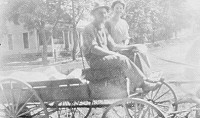

Prairie grass, trees and hills are what we saw when first we came to South Crawford County in 1877. There were few roads, few fences, no railroads, no schools, and few other settlers. Manning would be my future home but Manning was not there; our home was 10 miles northwest of where Manning would be.
It took quite some time before fences were put in. Farmers did not know the boundary lines of their land and they had to wait for surveying crews to tell them where they could put their fences. Many farmers farmed land they were not certain was theirs.
There was a Hockett cattle herd south of Manning. William B. Hockett maintained two corrals: one in the neighborhood of where Botna is now and another south of where Manning is now. He hired cowboys to herd these cattle on government owned land during the day and the cattle were penned in the corral at night. The cattle were herded from one corral one day, penned in the other, and back again the next day. The cowboys would strive to keep cattle on new grass so that they would be fattened for the farmer. Hockett would charge the various farmers 8c a head for caring for their cattle during the summer season. Each farmer would have to brand his own cattle before putting them in the herd and check occasionally to rebrand when necessary and brand the new calves. There were few fences, hence the reason for the herd.
When farmers had dairy cattle the children in the family had the task of herding them because the cattle had to be brought home to milk. Most farmers had a small yard where they could keep the dairy cattle during the night. My brother Ed (Wiese) and I were often given the job of herding cattle. I tried to raise prairie chickens (didn't succeed) and my brother tried to scare me (succeeded) by hiding in wolf holes.
My brother, Adam, born in the southern part of Crawford County, used to claim that he was the first white child born in the area.
When I was seven years old Mr. Hockett, wearing a broad black hat, black shirt, string of beads and moccasins, came to our place and explained that some of the brands on the cattle had grown out and perhaps my father (Detlef Wiese) should rebrand some of them. My father agreed to do that in the next week. He asked if I would care to come along. I was only too anxious to do that. We found the herd, heated up the branding iron which consisted of a "W", and branded the cattle.
As we headed north for home my father asked if I would like to see the new town of Manning. We found it and tied up the horses and watered them at a pump in the middle of the street (north of where the Manning Plaza is now). We took a drink from a tin cup that was there.
There were several brick buildings started from where the Johnson store is now and to the north, and they were about three or four foot high. When we saw them it was during the noon hour and the carpenters and brick layers were sitting on the walls swinging their legs and eating their lunches.
There was a wooden building on the corner (at the present site of the Manning Plaza) that was a saloon in front and sold groceries in back. My father went into and through the saloon to the grocery store and bought some crackers which we ate while we watched the workmen and talked about how fast the new town was growing. There was one house completed (where Edward Ramsey now lives), built for Matt Ferguson. My father and I tried to visualize what the town would look like in a few more months.
My father told me about an object he saw in the store. It was round and yellowish-red and they told him it was an orange. He had never seen one; I asked if he could buy one. He said he would see. He went in and brought one back but we really did not know how to eat it. However, we finally peeled it and each of us had some sections. I said, "Now we can go home and tell the rest of the family that we had an orange." He thought about that for a while, decided that might not be such a good idea, so he went in and bought another orange for the rest of the family. Ten years passed before I saw another orange.
During the late fall of 1881 Gus Jans, who at that time lived south of Manning, stopped and invited us to a dance in Manning. He was instrumental in getting a dance organized in the first completed building large enough for a dance. Later the building would be the Schelldorf clothing store.
Mr. Jans picked up a keg of beer at the Smutney Brewery in Vail, stopped at Westside to get a ham, managed to round up some bread, and invited people along the way to come to the dance at Manning. Six ladies came to the dance and several hundred men. They danced until morning.